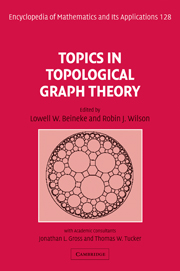Book contents
- Frontmatter
- Contents
- Foreword
- Preface
- Introduction
- 1 Embedding graphs on surfaces
- 2 Maximum genus
- 3 Distribution of embeddings
- 4 Algorithms and obstructions for embeddings
- 5 Graph minors: generalizing Kuratowski's theorem
- 6 Colouring graphs on surfaces
- 7 Crossing numbers
- 8 Representing graphs and maps
- 9 Enumerating coverings
- 10 Symmetric maps
- 11 The genus of a group
- 12 Embeddings and geometries
- 13 Embeddings and designs
- 14 Infinite graphs and planar maps
- 15 Open problems
- Notes on contributors
- Index
Introduction
Published online by Cambridge University Press: 05 June 2012
- Frontmatter
- Contents
- Foreword
- Preface
- Introduction
- 1 Embedding graphs on surfaces
- 2 Maximum genus
- 3 Distribution of embeddings
- 4 Algorithms and obstructions for embeddings
- 5 Graph minors: generalizing Kuratowski's theorem
- 6 Colouring graphs on surfaces
- 7 Crossing numbers
- 8 Representing graphs and maps
- 9 Enumerating coverings
- 10 Symmetric maps
- 11 The genus of a group
- 12 Embeddings and geometries
- 13 Embeddings and designs
- 14 Infinite graphs and planar maps
- 15 Open problems
- Notes on contributors
- Index
Summary
Graph theory
This section presents the basic definitions, terminology and notation of graph theory, along with some fundamental results. Further information can be found in the many standard books on the subject – for example, Chartrand and Lesniak [1], Gross and Yellen [2], West [3] or (for a simpler treatment)Wilson [4].
Graphs
A graph G is a pair of sets (V, E), where V is a finite non-empty set of elements called vertices, and E is a finite set of elements called edges, each of which has two associated vertices (which may be the same). The sets V and E are the vertex-set and edge-set of G, and are sometimes denoted by V (G) and E(G). The order of G is the number of vertices, usually denoted by n, and the number of edges is denoted by m.
An edge whose vertices coincide is called a loop, and if two vertices are joined by more than one edge, these are called multiple edges. A graph with no loops or multiple edges is a simple graph. In many areas of graph theory there is little need for graphs that are not simple, in which case an edge e can be considered as a pair of vertices, e = {v, w}, or vw for simplicity. However, in topological graph theory, it is often useful, and sometimes necessary, to allow loops and multiple edges. A graph of order 4 and its underlying simple graph are shown in Fig. 1.
Information
- Type
- Chapter
- Information
- Topics in Topological Graph Theory , pp. 1 - 17Publisher: Cambridge University PressPrint publication year: 2009
